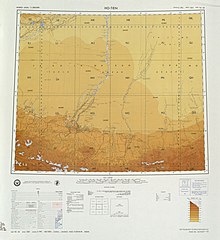Ho-t'ien
Appearance
English
[edit]
Etymology
[edit]From Mandarin 和田 (Hétián) Wade–Giles romanization: Ho²-tʻien².
Pronunciation
[edit]- enPR: hôʹtyěnʹ
Proper noun
[edit]Ho-t'ien
- Alternative form of Hetian (Hotan)
- 1923, The Travels of Fa-Hsien[1], Cambridge University Press, →OCLC, →OL, pages 90–91:
- Again, Yü-tʻien or Ho-tʻien (Khotan), as it is now called, has been from time immemorial devoted to Mahometanism, as is amply borne out by Illustrated Notices of Western Countries, printed by Imperial authority.
- 1966, Translations on People's Republic of China[2], United States Joint Publications Research Service, →OCLC, page 97[3]:
- The Ho-t'ien Special District in the Uighur Autonomous Region of Sinkiang, lying north of the K'un-lun Mountain and south of the T'a-k'o-la-ma-kan Desert, suffered regularly before the liberation from the menace of drought and sand storm.
- 1987, Arthur C. Hasiotis, Jr., Soviet Political, Economic, and Military Involvement in Sinkiang from 1928 to 1949[5], Garland Publishing, →ISBN, →LCCN, →OCLC, →OL, pages 102–103:
- In September of 1937, two regiments of Soviet Kirghiz troops and one regiment of Russian troops equipped with forty airplanes and twenty tanks entered Sinkiang from Atushe and attacked Pa-ch'u, dividing Ma Hu-shan's 36th Corps into two sections. In October one Kirghiz regiment entered P'i-shan, and Ma Hu-shan fled to India. Kirghiz and Russian forces were now in occupation of Hami and poised to strike at Ho-t'ien in the extreme south of Sinkiang.
Translations
[edit]Hetian — see Hetian
Further reading
[edit]- “Ho-t'ien”, in Collins English Dictionary.
- “Ho-t’ien”, in Merriam-Webster Online Dictionary, Springfield, Mass.: Merriam-Webster, 1996–present.
- “Ho-t'ien” in TheFreeDictionary.com, Huntingdon Valley, Pa.: Farlex, Inc., 2003–2024.
